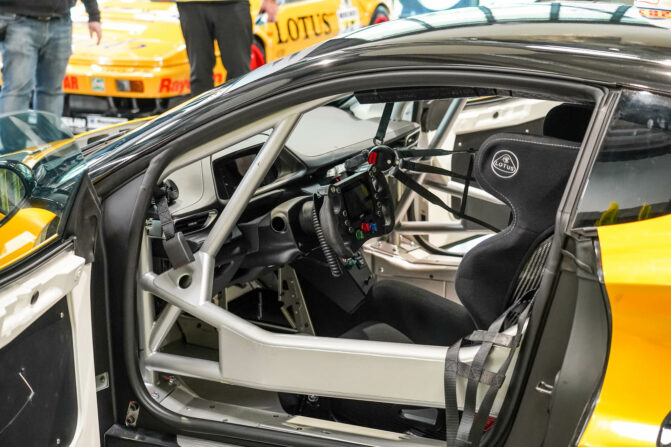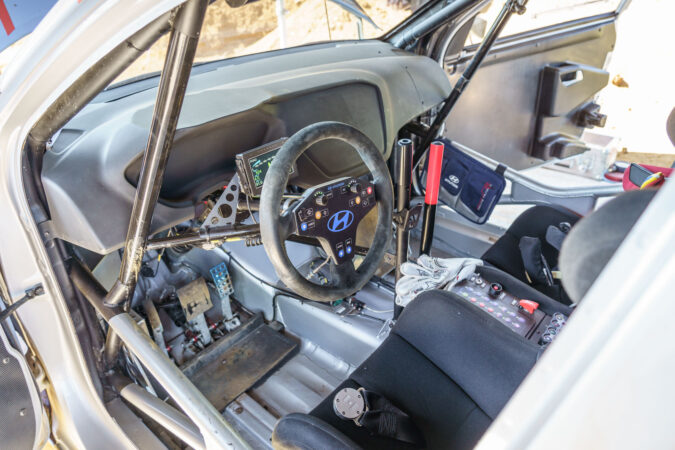You’ll notice that most race cars have a bunch of steel tubes inside them, otherwise known as a roll cage. And now you’re probably thinking that maybe you should install them to (somehow) make your car go faster. But hang on there, there’s much more to it than just fitting metal tubes inside your car.
This post will discuss everything about roll cages. From what they are, what they’re for, and whether or not it’s worth your time installing them in your car. Here’s all you need to know:
What Is It For?
A roll cage makes the car’s entire structure more rigid and stiffer. This has two benefits: first, it helps to improve handling. Whenever a car goes through a corner, it experiences changes in mass distribution and there are G-forces acting on the car.
As a result, the car’s body panel and chassis will flex due to these forces. The flex is invisible to the naked eye, but it’s there and it affects the car’s stability. Making the chassis and body stiffer reduces this flex. And as a result, the car becomes more stable, which makes it easier to handle and helps to improve handling.
Second, as the name suggests, it helps to protect the driver if the car rolls over. Adding rigidity to the structure ensures the roof doesn’t collapse if the car rolls over and lands on its roof. As you can imagine, this helps to prevent fatal accidents.
Most race cars—especially those that are based on road cars—need a roll cage for these two reasons. Additionally, the governing body of the racing competitions will also require them in the interest of driver safety.
Roll Cage Design
Roll cages consist of steel tubings that are welded together, and can be installed in a car in two ways: bolted or welded. Although for maximum efficacy, it should be welded onto the car’s chassis.
All of the types are similar in design. Of course, there is a variety in sizes to fit different cars. They’re usually classified by the number of mounting points they have, hence the term “x-point roll cage.”
However, note that there’s no standardized naming and the name may not always signify the mounting points. It may also signify the braces that the roll cage has. Perhaps, it’s best if we just explain the different types:
4 Point Roll Cage
The four-point type is the simplest one with the least amount of steel tubing. This type has two rear struts, a cross brace, and the main hoop behind the driver that follows the shape of the car’s B-pillar. The name four points come from the four installation points.
A similar variant is a five-point type, where it has an extra diagonal cross brace between the struts. However, it still only has a total of four mounting points.
Many people sometimes refer to this as a half cage or a roll bar, although it’s completely different than what an anti-roll bar is. Additionally, this is the type of roll cage you’ll most often see in factory road cars that come with a roll cage as standard, such as the 997-generation Porsche 911 GT3 RS.
While it’s the most basic type, certain designs of this roll type already meet the regulations of certain SCCA events. So, you don’t need to go more complex than this.
Since it requires fewer materials, this is the cheapest type of roll cage you can buy. Often you don’t need to weld it, and bolting it onto the car’s chassis is sufficient. Note that removing interior trims is still necessary to install the roll cage.
For reasons we’ll explain later on, this is the only type of roll cage you should install if you still plan on using your car for street use. Other types of roll cages can be a double-edged sword, but we’ll discuss more of that later. Here’s the next type of roll cage:
6 Point Roll Cage
The six-point roll cage typically refers to the type of roll cage that adds a hoop along the windshield and has a crossbar on the roof. This means there are an extra couple more mounting points on the front of the car.
However, some people may refer 4-point roll cage with two extra diagonal braces as a six-point type. It all depends on context, but we’re referring to the type where it has a total of six mounting points.
Most competitive racing typically requires at least a six-point roll cage. Although a four or five-point roll cage might suffice in competitions with slower cars. The speed of the car often dictates the level of roll cage safety it requires.
View this post on Instagram
If you’re building a race car or a track car that you won’t be using on the street, this is the way to go. It’s also cheaper than the next type as it doesn’t require as many materials. But if you’re still planning to use the car on the street, best stick with a four-point roll cage.
Other variants are the seven-point and eight-point roll cage. These types also still have a total of six mounting points. But they have an additional cross brace or two at the rear struts to increase strength.
10 Point Roll Cage
The 10-point (or more) roll cage is where you get serious, and this is the type you’ll find in race cars in professional racing competitions. The 10-point roll cage is similar to an eight-point type, but with a cross brace at the side hoop on both sides of the car.
Note that once you go beyond 8 points, a roll cage can have all sorts of variety in designs. It may have six mounting points, or it can have up to 10 where there are two additional mounting points on the side and another two that mount to the front part of the chassis.
It all depends on the car’s make and model, roll cage manufacturer, and what type of roll cage design they think fits the car best. Additionally, racing regulations may dictate the design as well.
One thing for sure is that this type isn’t necessary if you’re not doing any competitive racing. Especially if you still intend to use the car on the streets. Here’s why:
It’s A Double-Edged Sword
There’s something you should note before you install a roll cage in your street car: they’re only safe when you’re strapped in with proper racing harnesses and wearing a helmet. The roll cage can be a double-edged sword, and without these, it can cause a nasty injury.
The standard seatbelts in a car can only handle so much force. If the impact of the accident is powerful enough, your body will experience a lot of body movement during the crash. And there’s an increased chance that your head will hit one of the roll cage’s tubing, resulting in a head injury.
Hence why racing seats and harnesses are necessary. These ensure that you stay firmly in place during a crash. And the helmet will help protect your head just in case you still hit your head on one of the roll cage’s tubings.
It’s not a big issue if you install a four-point or five-point roll cage, as the steel tubings are behind you. And there’s virtually no chance that you hit your head on those.
However, the six-point type or more means there are steel tubings right on top or beside your head (depending on how tall you are). And hitting your head on them in a crash won’t exactly be pleasant. So, a roll cage without other these other safety devices is counterproductive.
Of course, you can put all these things in your street car and wear a helmet when you drive. But do you really want to do up a six-point harness and put on a helmet before you go to get coffee?
Also, while most states don’t stipulate that you can’t wear a helmet while driving on public roads, it may attract the attention of law enforcement. No one wants that. And there’s more:
Racing Harnesses Also Aren’t For Road Use
Using racing harnesses in a road car also has its own set of issues. For one, it’ll be hard for you to move around such as when you want to reach the air-conditioning controls or your cup of coffee. Looking around will also be difficult as the harness limits your shoulder movement.
There’s also a safety issue. The standard three-point seatbelt secures your body, and your neck and head. But racing harnesses don’t secure your neck, which means it will just be flopping around in the event of a crash.
This isn’t a big deal when you’re in a race or a track day, as you’ll be wearing a helmet and a HANS (head and neck support) device. But you won’t be wearing them on the street, and it can result in a more serious injury.
We can’t find a video that solely explains how it all works. But we do recommend watching the Porsche video above from Regular Car Reviews and skipping to the 10:10 point for the explanation.
In a nutshell, roll cages offer little benefits in a street car. And you should only install it if you intend to make a race car or turn your car into a track day toy. The handling benefits of a roll cage are probably not going to be noticeable on the road anyway.
If you still intend to use it on the road, we recommend not doing it very often. And you should do up the harnesses properly every time you drive the car on the road.
Roll Cage Kits
So, now that you’re aware of its benefits and risks, let’s talk about installing one in your car. There are two ways to go about this: kits and DIY.
Kits can come ready-made or custom-made, with the latter obviously being more expensive. Meanwhile, ready-made kits are cheaper, but it’s a pre-designed roll cage, it doesn’t look very fancy, and the cost doesn’t include installation.
You can look up your options on racing equipment retailers such as Summit Racing. You can filter by year, make and model, and other specs such as mounting points and price range. Here’s a quick summary of the potential costs depending on the roll cage type:
- Four-point costs between $230 to $400.
- Six-point to eight-point costs between $500 to $800.
- 10-point or more starts at $800 but are often above $1,200.
Note that the costs don’t include labor. You’ll often need to find a tuning shop that can install it for you, although some sites and cage makers will refer you to one.
Labor costs vary greatly depending on your car’s make and model, roll cage type, the shop’s labor rates, and whether you want to bolt-on or weld the kit. But on average, you can expect the job to take around 10 hours to finish. At $85/hour, that totals to $850 in labor.
You can see in the video above from Donut that even a basic four-point cage costs $2,000 before installation. It’s generally a good idea to prepare somewhere between $1,500 – $2,000 to install a roll cage kit.
If you want to browse some more, you can check CageKits, S&W Race Cars, and Safety Devices. Some of them don’t list the price of the kits but have a wider range of options than Summit Racing.
Custom Roll Cage
A custom roll cage can refer to either a cage kit with a custom design and finish (such as in the Donut video above) or a DIY roll cage. We’re referring to the latter for this article. So, are they worth the time and effort?
Needless to say, doing this yourself will require a lot of time, effort, and craftsmanship. If like me, you struggle to even put together a model kit, then this is probably not for you.
You’ll need to get your hands on steel tubings. The most common thickness is usually around 1.5 x 0.12 inches or 1.75 x 0.12 inches. And you’ll need around four to six tubes of 20 feet each for a four-point roll cage.
Then there’s the matter of steel types, some common ones include ROPT510 mild steel, BS4 T45, and 4130 or Chromoly steel. And there are the tools you will need, including:
- Tube notcher for cutting round notches at the end of tubes.
- Tubing benders for corner tube bending.
- Tape measure.
- Metal pipe cutter.
- Angle grinder.
We recommend watching the video above to get an idea of what the process entails. It will typically take a professional around 65 hours to make a high-quality roll cage, and we amateurs will probably take more than that.
While the video above shows how to make a six-point cage, we think even a four-point cage will not be worth the trouble. Additionally, the cost of buying or renting the tools necessary might even make it less cost-effective.
Overall, we think it’s just better to buy a roll cage kit instead and have a professional install it for you. It might be expensive, but it’s an essential safety kit in a race car and you shouldn’t skimp on safety.
Roll Cages in Motorsports Vehicles: Facts
- Roll cages are required by many racing organizations and are becoming increasingly popular as aftermarket safety upgrades for street cars.
- Roll cages reinforce the structure of a vehicle and help prevent it from collapsing in on itself in a rollover accident, providing occupants with more protection from being crushed by the vehicle.
- Roll cages can help distribute impact forces more evenly throughout the vehicle body in a collision, reducing the likelihood of serious injuries occurring.
- A well-designed roll cage can improve the handling of a car by stiffening up the chassis and resulting in less body flex.
- A roll cage can add resale value to a vehicle by adding strength to the frame, protecting vital components in an accident, and potentially improving performance.
- Roll cages should be designed and installed by professionals to ensure they meet safety requirements and are effective in protecting occupants.
- Roll cages can be made from a variety of materials, including steel, aluminum, and titanium.
- The type and design of the roll cage needed will depend on the specific vehicle and intended use, as well as any relevant safety regulations.
- Roll cages can add weight to a vehicle, which may affect performance and handling, so it’s important to consider this when choosing a roll cage.
- Regular inspections and maintenance of a roll cage are necessary to ensure it remains effective and in good condition.
Frequently Asked Questions
We’re sure you have more questions about roll cages, here are some answers you might find helpful:
What Does A Roll Cage Do
A roll cage acts like a strengthening beam for your car. It increases rigidity and stiffness in the car’s chassis to improve handling and safety. In the event of a roll, the roll cage will prevent the car’s roof from collapsing and decreases the chance of a fatal accident.
How To Build A Roll Cage
Building a roll cage requires you to purchase the steel tubings and get hold of several tools, such as a grinder, a welder, and a tube bender amongst others. You’ll need to remove the car’s interior trims, mark the mounting points, and then create plates for the mounts before you can start bending the tubes. You’ll then need to install the hoop first before you start welding the cross bars inside the car. The process takes at least 65 hours for a professional to finish, and we think it’s just easier and more cost-effective to buy a roll cage kit instead.
How To Install Racing Harness Without Roll Cage
You’ll need to remove the rear seats if there are any and then bolt the harness’s mounting point onto the rear part of the chassis. The belt should be at no more than a 45-degree angle from the shoulder line. The process varies depending on your car’s make and model, and the type of seats that you have in the car. It’s best to follow the instructions religiously, most renowned harness makers such as TAKATA provide you with a manual. If you’re unsure, best to have a professional install it for you. Racing harnesses are essential for safety and incorrect installation can cause more harm than good.
How To Bend Roll Cage Tubing
The easiest way is to use a tube bender which costs around $400 on average. You insert the tube into the bender and make sure you’re bending it at the correct point. And then set the bender on how many degrees you want to bend it, and then turn it on and the machine will do its job. You can also use roller stands or a heat gun to bend it, which are cheaper but it’s just a lot easier to use a bender.
How Much Does A Roll Cage Cost
A roll cage kit costs between $230 to $1,500 on average before installation. The labor cost to install them is usually around $850, but likely more for complex types such as a 10-point roll cage. The make and model of your car will also affect the cost, as it may be more difficult to install it in certain cars. You should prepare at least around $1,500 to $2,000 for a roll cage installation. And if you custom-order them, it’s anywhere between $3,000 to $4,000.
Is A Roll Cage Worth It
If you’re building a track car then it’s worth it, and necessary if you’re building a race car. Governing bodies of competitive racing will require you to fit in a roll cage to enter the competition. However, if you’re thinking of it installing it in your street car, then you’re better off spending the money elsewhere. Tires, brakes, shocks, and anti-roll bar upgrades will produce similar handling improvement results. Additionally, a roll cage can be dangerous in street cars if you don’t use racing harnesses and a helmet.
When Should You Get A Roll Cage
In drag racing, a roll cage is mandatory for all cars that do the quarter mile in 9.99 seconds and quicker or any car running 135mph or faster. Cars faster than these need to have a roll cage to participate in NHRA-sanctioned events.
What Size Tubing For Roll Cage
The thickness is usually 1.5 x 0.12 inches or 1.75 x 0.12 inches, and you’ll need around 20-foot long tubing. You’ll need about four to six of them, and more if you choose to build a six-point or more roll cage.
Final Thoughts
To summarize, installing a roll cage will increase the rigidity of the car’s structure. And this improves the car’s handling and safety. While it’s great, you shouldn’t install a six-point type (or more) in a street car. You risk hitting your head if you don’t use racing harnesses and a helmet and it will be counterproductive.
If you plan to install it in your street car, we recommend installing the four-point type instead since there’s virtually no risk of hitting your head on it in a crash. Even so, you’re better off upgrading other things first if you want to improve your car’s handling.
These include performance tires, bigger brakes, an anti-roll bar, and performance shocks and struts amongst others. All of these things will make a big impact and improve your car’s handling.
If you’re going to enter your car in competitions, make sure that the roll cage you’re fitting meets the standards and regulations of the governing body. And as a whole, you’re better off having a professional install it for you—even if it costs a lot of money.
Hey, no one ever said that cars—especially racing them—is a cheap hobby now have they? Anyway, hopefully, this has been helpful for you, and good luck!




